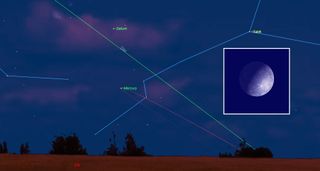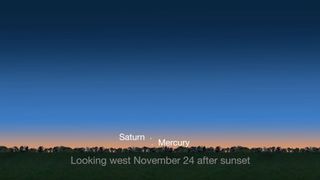See Elusive Planet Mercury at Its Best This Thanksgiving

Now is the time to look up and see Mercury, a planet that usually lingers too close to the sun for skywatchers on Earth to observe.
Mercury will reach its greatest elongation — the point in its orbit at which it appears to be the farthest away from the sun as seen from Earth — today (Nov. 23) at 7 p.m. EST (0000 GMT on Nov. 24). Because of its apparent distance from the sun, Mercury will shine brighter than usual at magnitude -0.4.
To find Mercury, look low on the western horizon around sunset. The planet will appear 22 degrees east of the sun, or a little more than twice the width of your fist held at an arm's length. It will be visible to the naked eye for up to an hour after sunset. Before sunset, however, bright light from the sun can make it difficult to see. [The Thanksgiving Night Sky 2017: Here's What You Can See]
While Mercury will be in the best position to be viewed from Earth, not all places on Earth will have the same nice view of this celestial event. In New York City, for example, Mercury will be a mere 6 degrees above the horizon at dusk, so buildings, trees and landscapes will likely get in the way.
According to EarthSky.org , skywatchers in mid-northern latitudes will have less than an hour to spot Mercury after sunset and before the planet sets below the horizon. Viewers near the equator will have about 1.5 hours to see Mercury after sunset, and viewers in the Southern Hemisphere can expect about 45 minutes of quality Mercury-observation time. To find out when Mercury and the sun will set in your area, check out this calculator by The Old Farmer's Almanac.

If you do go look at the sky to find Mercury, keep an eye out for Saturn as well. Both planets will be shining brightly by the western horizon at dusk for the rest of this month.
Email Hanneke Weitering at hweitering@space.com or follow her @hannekescience. Follow us @Spacedotcom, Facebook and Google+. Original article on Space.com.
Get the Space.com Newsletter
Breaking space news, the latest updates on rocket launches, skywatching events and more!
Join our Space Forums to keep talking space on the latest missions, night sky and more! And if you have a news tip, correction or comment, let us know at: community@space.com.

Hanneke Weitering is a multimedia journalist in the Pacific Northwest reporting on the future of aviation at FutureFlight.aero and Aviation International News and was previously the Editor for Spaceflight and Astronomy news here at Space.com. As an editor with over 10 years of experience in science journalism she has previously written for Scholastic Classroom Magazines, MedPage Today and The Joint Institute for Computational Sciences at Oak Ridge National Laboratory. After studying physics at the University of Tennessee in her hometown of Knoxville, she earned her graduate degree in Science, Health and Environmental Reporting (SHERP) from New York University. Hanneke joined the Space.com team in 2016 as a staff writer and producer, covering topics including spaceflight and astronomy. She currently lives in Seattle, home of the Space Needle, with her cat and two snakes. In her spare time, Hanneke enjoys exploring the Rocky Mountains, basking in nature and looking for dark skies to gaze at the cosmos.
